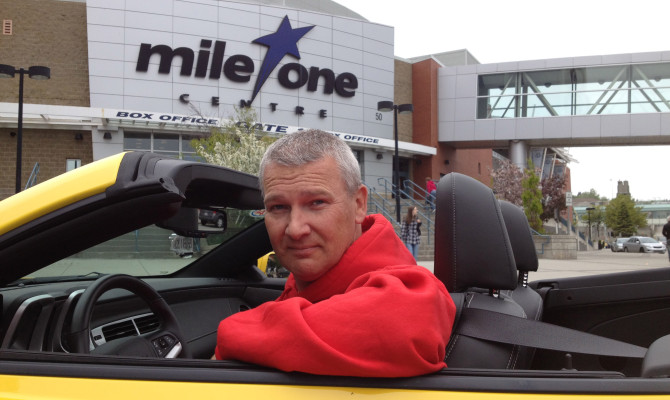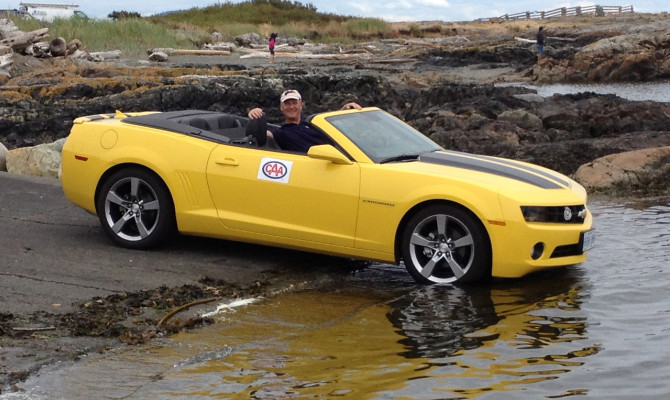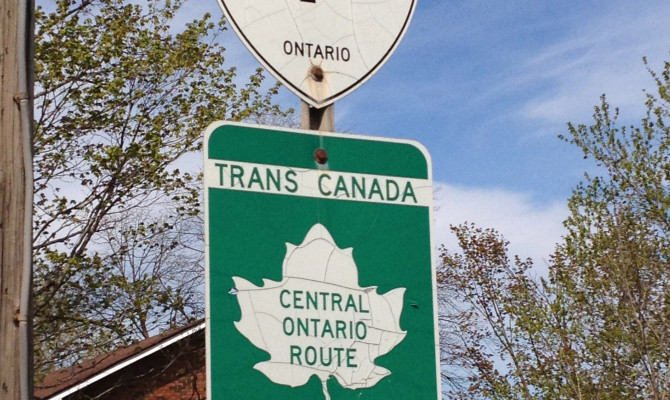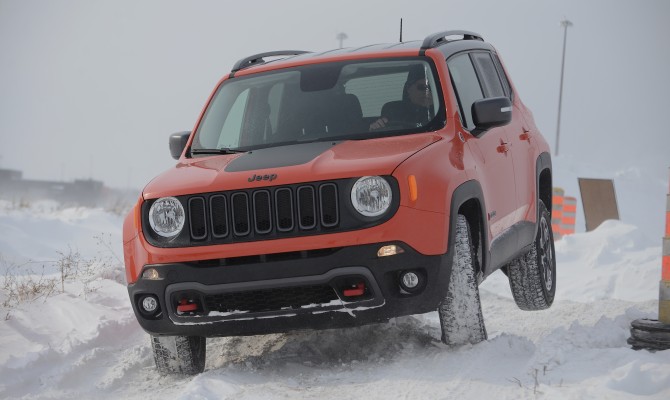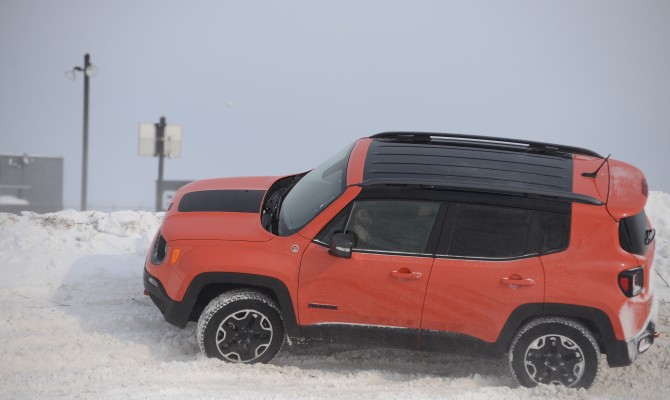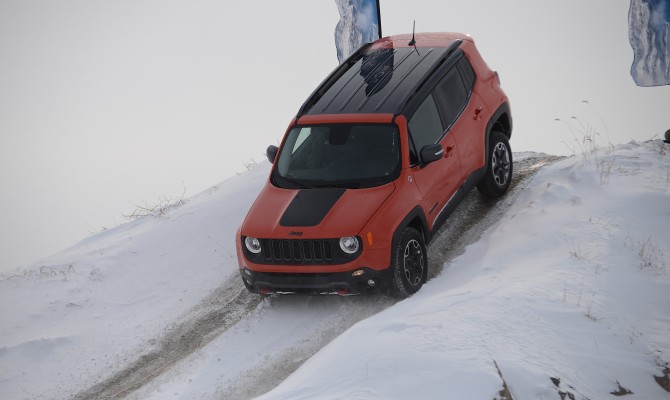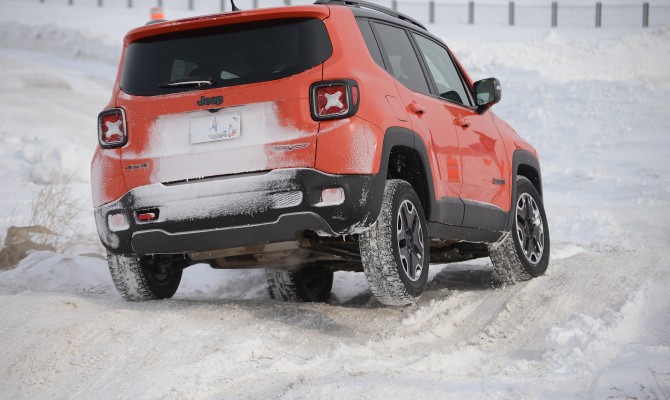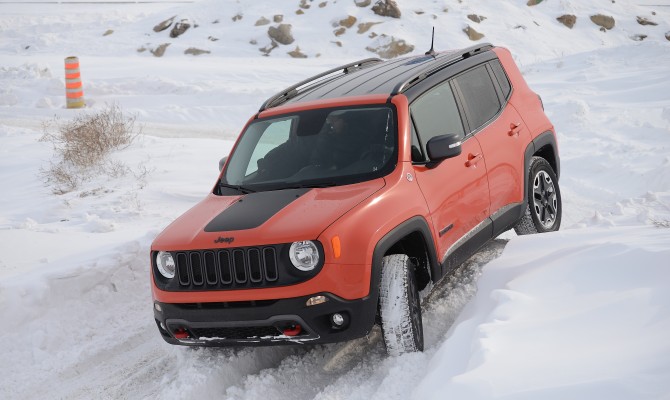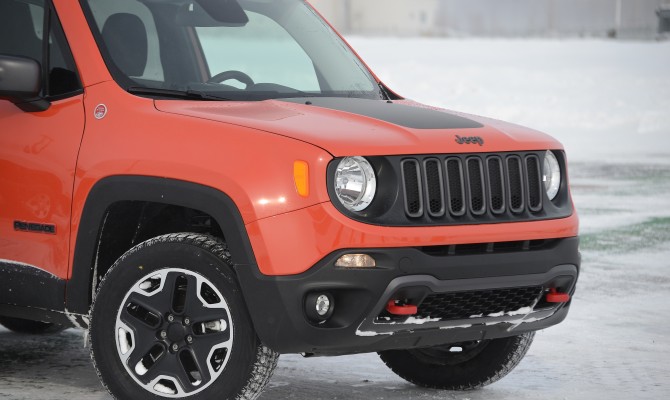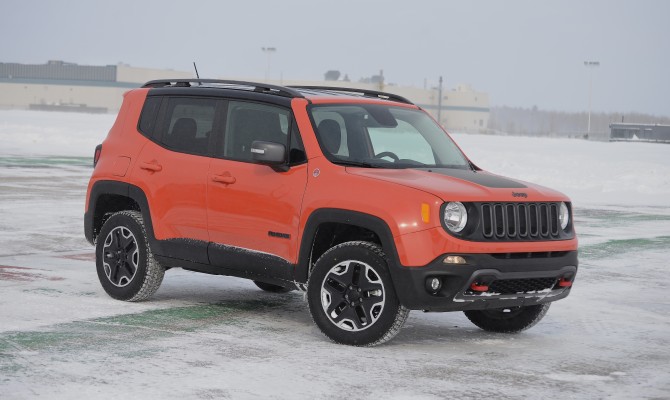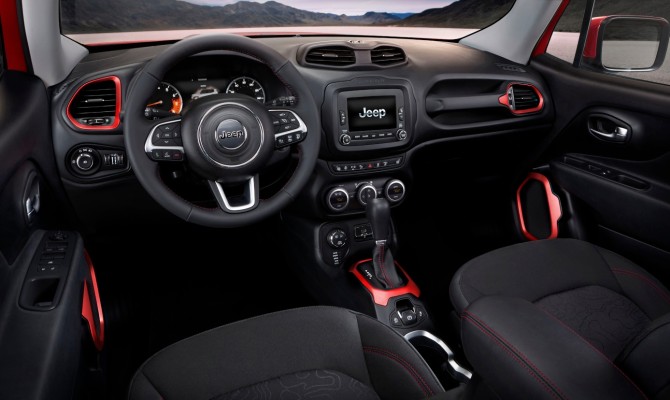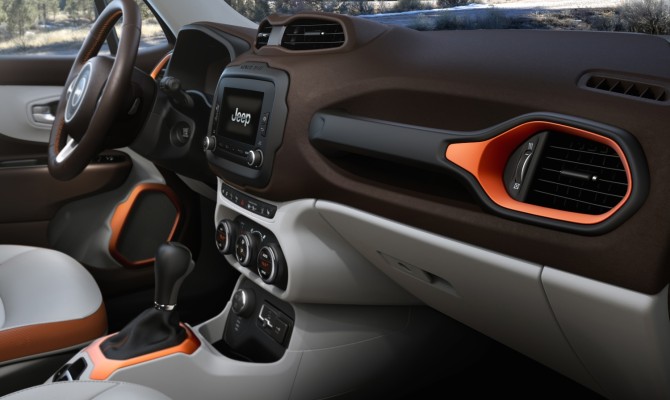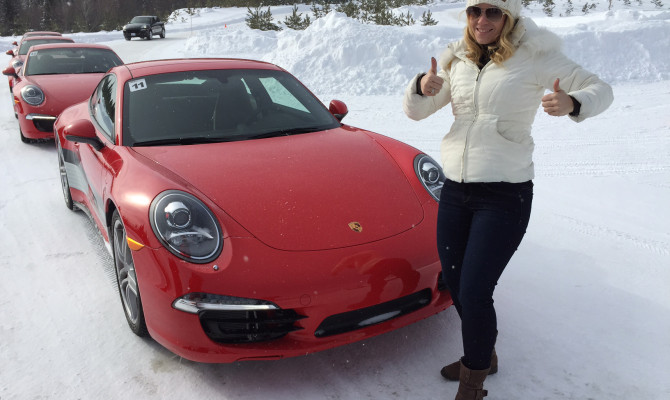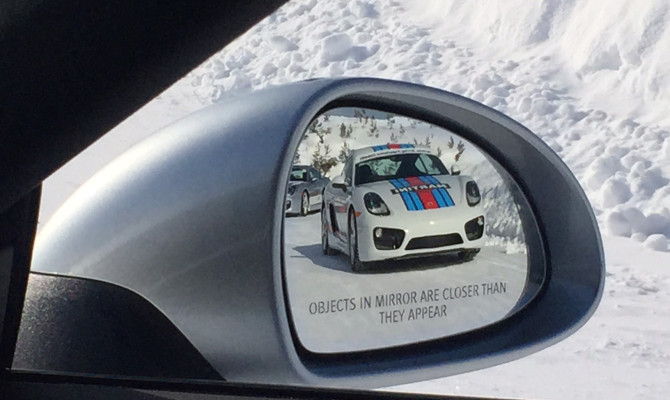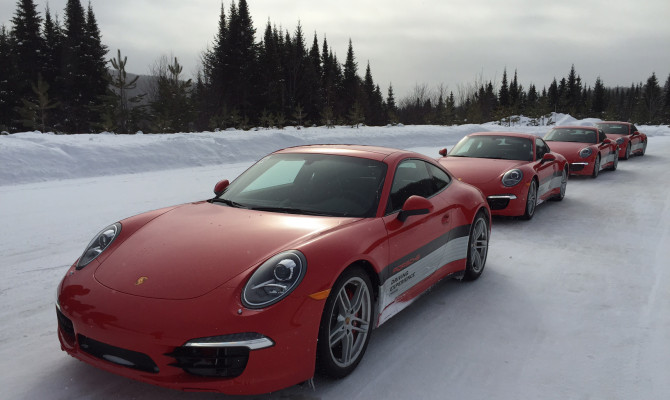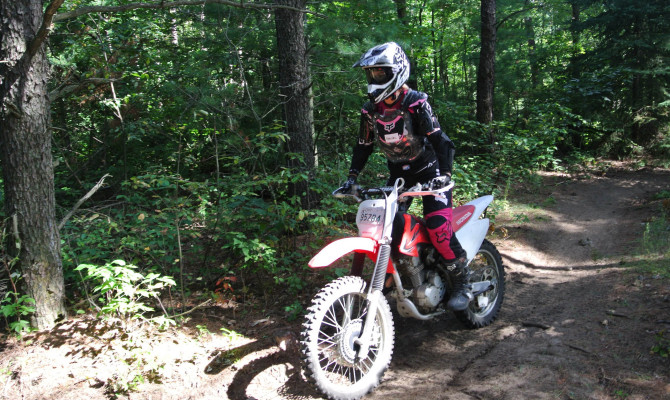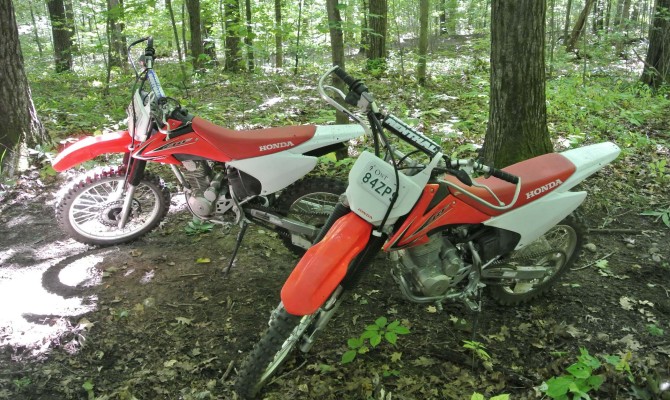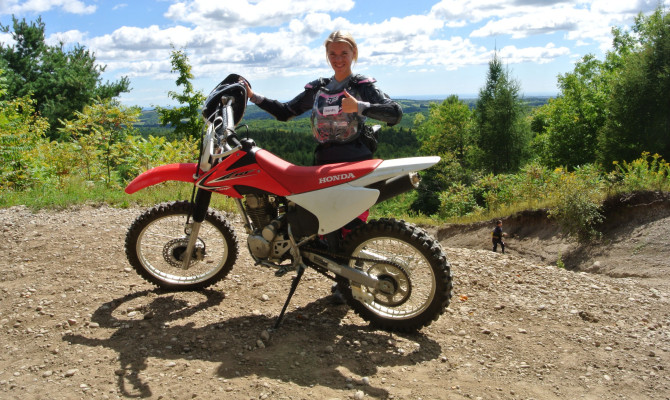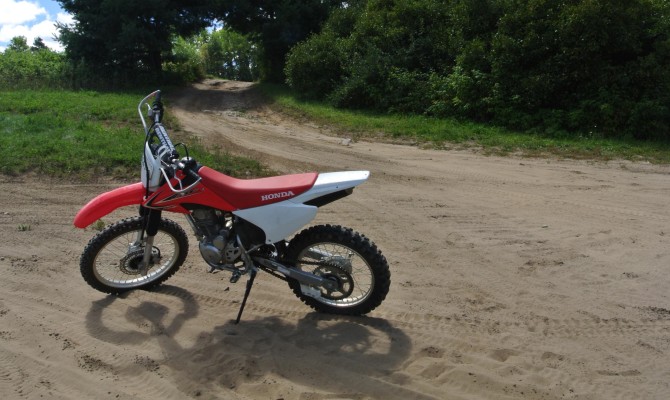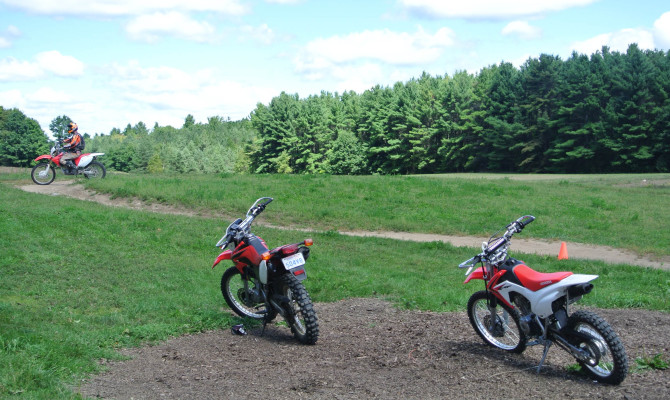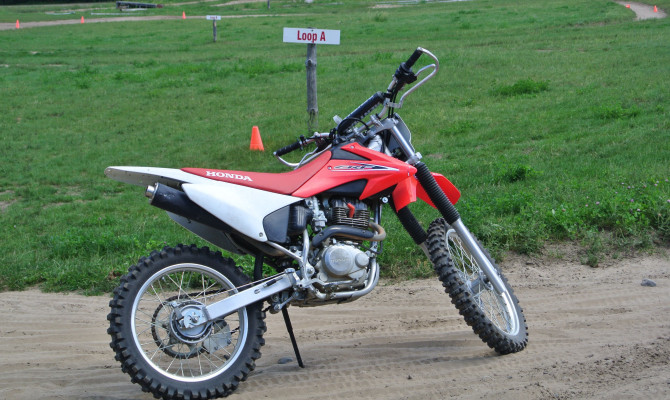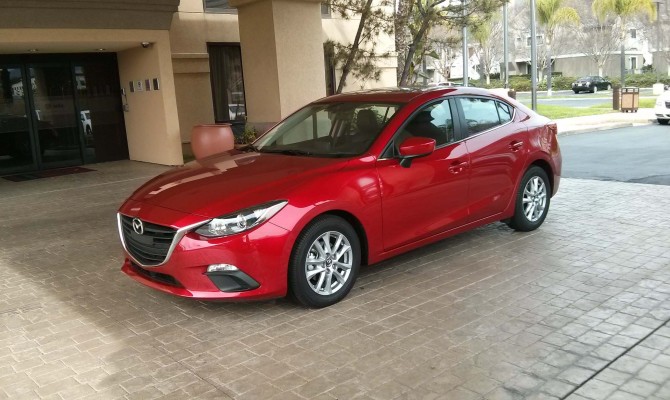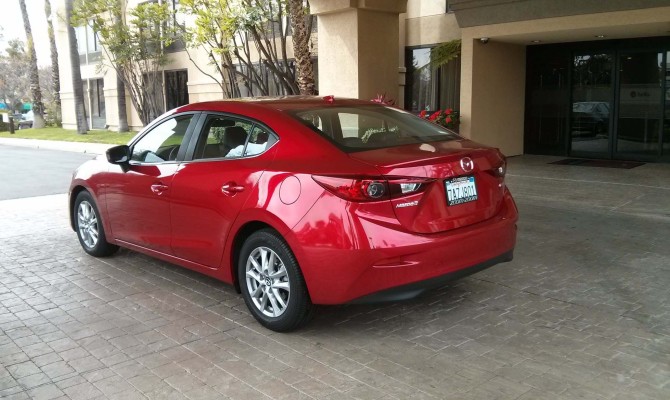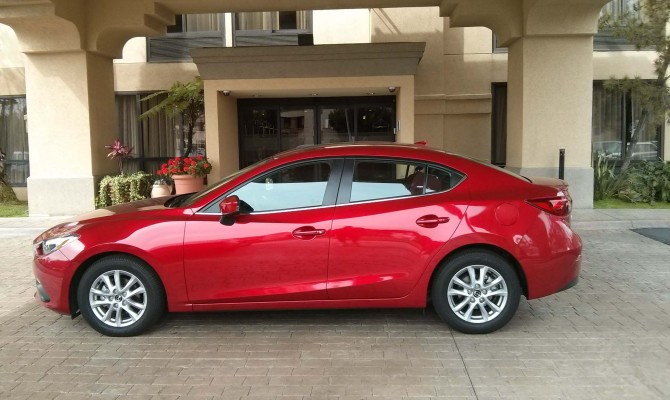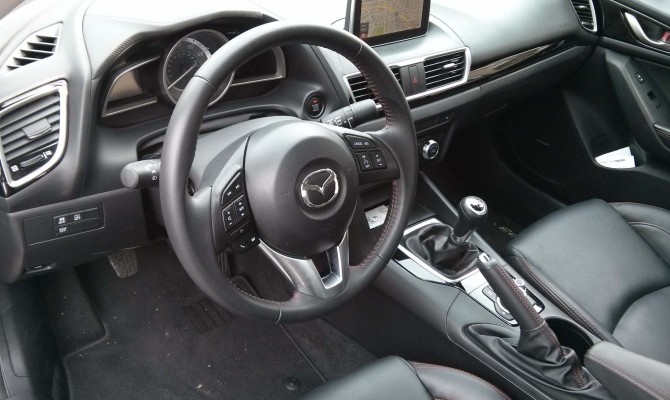Driving across Canada’s is on many people’s bucket list. Respected auto journalist Mark Richardson recalls his journey along Canada’s Road.
Canada’s a big country, second only to Russia in size. The highway that links her 10 provinces is 7,700 kilometres long, and I drove it in the summer of 2012 as research for my book, Canada’s Road.
Actually, that should be “research” with wagging quote fingers, because I’m always looking for a good road trip. Road trips are usually rushed affairs, hustling somewhere to enjoy the drive but with little time to stop and enjoy the scenery, but that summer, I slowed it all down and took 10 weeks for the drive. Much better.
It helped that my ride was a 2012 Chevy Camaro convertible, supplied for the trip by General Motors. It was loaned for three months; I put almost 27,000 kilometres on it, driving back and forth and twice across the country. The only thing I needed to change on it was the oil, and it didn’t put a tire turn wrong.
That year was the highway’s 50th anniversary, opened by Prime Minister John Diefenbaker on Sept. 3, 1962. I wanted to know if our Canadian icon is still important or just something now to brag about at international cocktail parties. There are lots of roads in the world; there are plenty of highways in Canada. What makes this one so special?
It was often a surprise for people to realize the TCH is only 50 years old – it’s taken for granted these days that there’s a road leading pretty much anywhere we want to go, and the road has always been there.
In fact, it’s been just a hundred years since the very first Canadian coast-to-coast road trip, driven by two guys in an open REO. Thomas Wilby and Jack Haney took 53 days to make it from Halifax to Victoria, but there were no roads in many parts of the country; when they reached North Bay, they had to put their car on trains and boats to cross the 1,700 km to Winnipeg, and in the Rockies, they had to detour through Washington state for a while.
The final road that made it possible to drive the width of Canada was not built until 1943, a stretch of gravel from Hearst to Geraldton in northern Ontario. It wasn’t the Trans-Canada, although it became a part of it when Diefenbaker eventually declared the highway open.
That was a proud day for Canada, despite both Newfoundland and New Brunswick boycotting the ceremony at B.C.’s Rogers Pass; the two provinces were holding out for more money to finish paving and smoothing the road. The TCH really wasn’t complete until 1970, and even now, billions of construction dollars in Quebec and Alberta are widening the road into four lanes to make it safer and more efficient.
The Trans-Canada is not always such an impersonal, high-speed highway. There are still many kilometres of two- and three-lane asphalt, winding through some of the most scenic areas of the country.
We have the Rogers Pass and the Kicking Horse Pass – impossible roads through high mountains considered impassable a few generations ago. We have the Fraser Canyon, clinging to the cliffside. We have the panoramic prairie, wide and swift. And we have the north shore of Lake Superior, built expressly as a scenic route to attract international tourists. On a clear day, there is nothing to surpass driving through a deep rock cut and dropping down through the green forest toward the shoreline of the broad lake, blue in summer, white in winter.
In Quebec, the TCH unfolds as an anonymous fast highway toward the Gaspe but encourages tourists to turn onto its original route, Hwy. 132, which runs close and parallel and follows the picturesque southern shore of the St. Lawrence. And in New Brunswick, the Trans-Canada sweeps drivers beside the Saint John River and toward the coast; it crosses into both Prince Edward Island and Nova Scotia and then up to Cape Breton, becoming for a few dozen kilometres a part of the Cabot Trail.
Then over on the ferry to Newfoundland, where the highway is the only link between the island’s west and east, just as it is on the other side of the country; in British Columbia, it’s the only paved link on Vancouver Island to Victoria, at the other end of another ferry.
The Trans-Canada Highway may not be the most efficient road in the world, and it still has a few dangerous twists and turns, but yes, it’s still important and it makes a great road trip, however long you’re able to take for the journey.
It’s a true Canadian compromise: a bit of everything for everyone – beauty, industry, and practicality – that pushes through our differences to link the country.
Mark Richardson’s book, Canada’s Road: A journey on the Trans-Canada Highway from St. John’s to Victoria, is published by the Dundurn Press.
“The Jeep Renegade follows on the heels of some other stylish compact crossover vehicles like the Kia Soul and Nissan Juke that provide a bit more flair, rather than just practicality.”
Not that long ago, if an all-wheel drive (AWD) vehicle was on a buyer’s shopping list, the options were largely limited to SUVs and trucks.
Today the automotive landscape has exploded with manufacturers offering many more AWD vehicles. In fact, 48 percent of all vehicles purchased in Canada come with AWD or four-wheel drive (4X4).
For Fiat Chrysler Automobiles Canada (Formerly Chrysler Canada) the percentage is even higher, at roughly 58 percent. Thanks, in part, to the success of the Jeep brand and the many vehicles sold under that off-road-ready marque. The latest entry, the Jeep Renegade, will be arriving at dealerships around April but just last week I had a chance to drive this small Jeep in classic Canadian winter conditions just outside of Montreal.
Looks
The setting for the winter driving program was at ICAR, an enthusiast’s racing facility built on the abandoned aprons and taxiways of the old Mirabel airport, including a slalom course, road coarse and off-road adventure. The bold orange Renegade instantly jumped out against the howling wind and at-times, whiteout conditions. The Renegade is built in Europe on the same platform that Fiat uses to make the all-new Fiat 500X. This cost sharing, multi-vehicle offensive is what has helped Fiat Chrysler Automobiles (FCA) to be so successful over the past few years. The engineering and design was done in Michigan to insure the Renegade has all the classic Jeep characteristics, from the round headlamps and classic Jeep grille, to the trapezoidal wheel arches, appropriate ground clearance and overall bold styling. The Renegade is smaller than the Compass and Patriot models in the lineup, helping to promote the red-hot, small crossover segment even further.
Inside
With a high seating position and boxy roofline, the Renegade has a lot of headroom and large windows, making this compact crossover feel open and airy. The dash and surrounding trim is filled with eye-catching touches, like the speaker grilles and air vents that come painted for more panache. The front seats are supportive and provide a nice look down the long hood, making this feel more “trucky” The back seats offer plenty of room in this class and the cargo area is what Jeep calls class leading. Prices start at $19,995 for base Sport model with front wheel drive (FWD) and the first AWD model starts at $25,995. The volume leader will be the North trim with alloy wheels, starting at $27,494 for an AWD version. The problem will be the higher end trims, like the $31,995 Limited, that look pricy compared to a bigger to a compact SUV, like a Honda CR-V, with a much more powerful engine, vastly bigger interior and a $30,000 AWD starting price.
Drive
FCA didn’t just have the Renegade to drive in frozen weather, rather a selection of the seventeen vehicles they offer with AWD or 4X4 capability. They were clear to point out that nine of the twenty-six models have AWD available even on the base trim. The Renegade’s base AWD system is a lighter weight active powertrain that can disconnect the rear wheels to save fuel but reconnect them in a fraction of a second if the temperature drops of the windshield wipers are turned on. On dry pavement, the system only needs to detect the slightest wheel slippage to engage the AWD capability. In addition there is a terrain select knob in each model that lets the driver choose between auto, snow, sand, mud and rocks to alert the Renegades’ traction control, stability control and engine/transmission electronics to keep the Jeep moving in different situations. The ultimate is the AWD system with a low setting for crawling over rocks, something Jeep purists appreciate.
Verdict
The Jeep Renegade follows on the heels of some other stylish compact crossover vehicles like the Kia Soul and Nissan Juke that provide a bit more flair, rather than just practicality. This new Renegade also has the advantage of being equipped with two sophisticated AWD systems to keep it ahead of the pack. The base engine is a 1.4L turbo 4-cylinder with 160hp but this model is only available with a 6-speed manual transmission; if the buyer wants and automatic, the larger 180hp 2.4L 4-cylinder is fitted with a class leading 9-speed automatic. There is a whopping $2,990 premium to get the larger engine and automatic on the Sport trim and just $1,495 on the North, excluding the price premium to get AWD. At the end of the day this Jeep has a very attractive exterior and interior and is something fresh in one of the hottest segments in the market. The price can jump very, very quickly if the buyer wants AWD and automatic. Time will tell if buyers will spend the extra to buy the higher end models.
Contact: zack [dot] spencer [at] drivewaybc [dot] ca
The Lowdown
Power: 1.4L turbo with 160hp or 2.4L with 180hp
Fill-up: N/A
Sticker price: $19,995-$31,995
“For someone learning to be a better winter driver, having appropriate tires, a mechanically sound vehicle and the right teachers will certainly increase confidence…”
Mecaglisse, Quebec.
Whatever your craft or hobby of choice is, having the right tools to execute your activities is paramount.
As an avid scrapbooker, I couldn’t imagine my life without a sharp pair of scissors, photos, flashy paper and double-sided tape. If you’re a runner, proper footwear mitigates injuries and minimizes blisters.
For someone learning to be a better winter driver, having appropriate tires, a mechanically sound vehicle and the right teachers will certainly increase confidence in slippery situations.
Enter Porsche’s Camp4: a winter driving program available to everyone. It’s an event I’ve attended before and learned a lot from.
But what’s it like for someone who’s already considered a professional driver? – BC resident Scott Hargrove is well versed in racing. He joined our group of international journalists on the program.
At 20 years old, he’s the current GT3 Porsche Cup Challenge champion in Canada. He also took home second place in the Pro Mazda Championship Presented by Cooper Tires. That was just his 2014 race year. His résumé is impressive and he knows a thing or two about car control. Then again, we can all learn something new, no matter how good we are.
“Driving on snow and ice is extremely different to any situation I have been in before,” remarks Scott.
“The technique is completely different compared to racing on pavement, where the fastest way around the track is the smoothest. On snow and ice, it’s all about pitching the car sideways and using the throttle to execute the turn. So despite my extensive racing background, this was a whole new experience for me with a whole new learning curve.”
Each Porsche at Camp4, whether it be a Cayman, Carrera, rear or all-wheel drive, were equipped with Nokian 1.5mm studded tires.
Yes, we needed grip but we also wanted to slide these amazing machines sideways!
As the group is having the time of our lives, the purpose of the activities is to connect with the car and feel how the ice track beneath us is ever changing. Each lap brings new challenges – sometimes it got so slippery our only option was to spin out – or as the instructors would say, “we’d run out of talent!”
The unnerving feeling – exhilarating in most cases – of pitching a car into a corner and holding the slide leaves you with a real sense of accomplishment. Or left me wanting to become a rally driver.
Underneath the smiling faces is a much more satisfying feeling; the feeling of being more confident in yourself and your abilities to adapt to different environments.
As Scott and I are chatting, I ask why he thinks this kind of training is both good for him and every other driver out there.
“Camp 4 will teach you more about car control over any other form of high performance driving school,” Scott says.
“Being in a low traction environment allows you to slide a car at slow speeds. Drivers can then get a feel for what is like to slide a car, react appropriately and recover. This experience will translate directly to the street and help any driver in an emergency situation.”
Learning to be a better driver and having a lot of fun doing it? Yes, I’m ready for that.
So is Scott.
“I would go back in a heartbeat,” he adds.
“Who wouldn’t love to drive a whole range of Porsches in the snow? It’s an experience you don’t get to have very often and one you definitely don’t want to miss out on!”
Visit http://www.porsche.com/canada-pde/en/yourcamp4/ for more information on Porsche’s Camp4.
“Green cars were in evidence in Montreal but when the shows reach the west, you can expect to see many more cars for the eco-conscious drivers.”
(more…)
Nissan Canada is supporting 21 in-need high school football teams across the country this year, and the manufacturer has launched its own YouTube documentary series to showcase those on the receiving end.
“Over the course of several webisodes, we’ll learn that, despite devastating funding cuts, high school football is needed as much now as ever,” reads the caption for Episode 1.
Called Back in the Game, the show will chronicle the seasons of two teams – in Edmonton and Hamilton – as they prepare for their 2014/15 season.
Episode 1 – embedded above – was released on September 19, 2014. (More clips have been embedded below.)
Full new episodes will all be available on Nissan Canada’s YouTube channel or at www.BackintheGame.ca.
******************************
Nissan: Back in the Game – The Announcement
Ganaraska Forest, Ontario.
“Remember, the trees don’t move,” coaches Al Lakas, chief instructor at Trail Tours.
These words offer some solace but little consolation to the confines of singe-track riding.
Claustrophobia is not a regularly referenced noun in my vocabulary, but when the local fauna and flora of the Ganaraska Forest are a hair’s length from your body, and the trail is inches wider than the handlebars of your bike, it’s hard to ignore.
The Medusa-like temptation to fixate on upcoming vegetation must be overcome. If you do happen to focus on them, it could be game over.
“Oh, shoot, there’s a stum…”
Thud.
There goes the front end of your bike, and probably you.
If you look down, your handlebars might do a jig-like dance, and chances are, that’s where you end up. Down.
Breathing through the anxiety is one way of conquering the trails. Another is a strong foundation in riding. But the most important of them all: vision.
Before heading out onto the over 300 kilometres of trails nestled within the 11,000 acres of Ganaraska Forest, Trail Tours instructor Al gives my riding partner and I a lesson in a much less confining location.
Thank goodness.
Nestled in the heart of the seemingly limitless dirt biking and motorized vehicle playground is Trail Tours (www.trailtour.com.) It’s just over an hour’s drive east from Toronto and well worth the short-haul journey. After parking the car and walking a few paces through a trail, the world gets a little brighter. Literally and metaphorically.
The sinewy trees – well, in comparison to west coast wood – that lead us to home base doesn’t let in a ton of light, so at the end of the trail, where Trail Tour’s open field training facility stands before me, the sun overflows like a perfectly-iced cake (you can never have too much icing.)
Also, I’m going dirt biking. How could that not brighten your day?
Whether you’re a first timer or an experienced rider, they have a program for you.
Though this wasn’t my first rodeo in terms of dirt riding, it was in regards to single-track.
I could use all the tips and tricks I could get.
Furthermore, I could always use a little more practice riding in the sand. Yikes.
Day 1 of the two-day adventure consisted of making sure the techniques for single-track riding were fresh in our minds.
It’s best just to ignore the trees or whatever hazards engulf you and the bike. Acknowledge them, but don’t stare. Otherwise, your fate will likely be sealed.
After practicing in the various loops – there are different areas of their facility that cater to different techniques – it was off to the practice trail.
Needless to say, I was not setting any speed records but it wasn’t about speed. That comes with time and experience. It was getting used to the fact that I didn’t have a lot of wiggle room and that my mind would want to play tricks on me if I didn’t relax, let the bike and myself breathe, and enjoy the best that machine and Mother Nature have to offer.
Day 2 was a game changer.
I was so happy that I did some basic skills the day before because I embraced the various tones and textures of the perpetually evolving geography around me.
Rocks, gravel, soil, sand (oh, there was a lot of sand), steep inclines, tree stumps, sharp corners, you name it, the Ganaraska Forest has it.
Though I didn’t go at it alone. Groups were organized by skill level and were lead by individuals who know that forest like the back of their hand. Heck, I would have been lost after the first two turns.
If you found that throughout the day you wanted a more advanced riding, or wanted to take it easier, movement between groups was entirely possible. The name of the game there is safety, with fun at an extremely close second.
Challenging yourself, your mind, your body and the bike is all part of the package.
And what an incredible way to do it.
Trail Tours is open from May until the end of October.
Visit www.trailtour.com for more information.
Whether you just drive it around the city or beyond, the Fiesta one-litre is a sturdy road companion with impressive fuel economy.” (more…)
Driveway editor Keith Morgan took a couple hot laps with F1 champion Sebastian Vettel and former Formula 1 racer David Coulthard, while the two of them and their Red Bull-Infiniti team were in Toronto before heading off to the Montreal Grand Prize in Quebec.
It was the second time Morgan had ridden with Vettel, and the second time their meetings have crossed just before Seb has finished on an F1 podium.
“It’s all down to you,” the champ said, while taking Morgan on a windy, whipping turn around the track at Bowmanville, Ontario.
Videos: Keith Morgan, Driveway
Seb’s seat time with Driveway editor Keith Morgan clearly paid off as he went on to take his fourth straight championship… (more…)
Our American friends have a choice of six Mazda3 trim levels, while Canadians have only three…
During a recent short stay in Los Angeles, I drove a Mazda3i Grand Touring.
It’s a trim level that’s not available in Canada, even though Mazda3 is more popular (comparatively) in Canada than in the U.S. And price, well, that also turned out to be a surprisingly interesting comparison.
It’s easy to understand why so many Canadians already love Mazda3. The 2014 edition is an improved all-new generation car that’s already been voted Canada’s Best New Small Car, by the Automobile Journalists Association of Canada (AJAC).
Softer, more flowing body styling lines cover a new SkyActiv structure that’s lighter yet, according to Mazda, offers a 30 per cent improvement in torsional rigidity. The 3’s wheelbase has also been stretched by 6 cm, yet it’s a tad shorter in overall length. Inside the cabin there’s more room, especially leg and head room for the rear passengers.
Mazda3i GT Sedan: A top-line GT (Grand Touring) edition of Mazda3 is available in Canada, but only with a larger 2.5-litre SkyActiv engine and an automatic transmission. The 3i GT that I drove in L.A. came with the smaller 2.0-litre SkyActiv engine and a 6-speed manual transmission. An automatic is an option in the US and there’s also a 3s GT edition with the 2.5-litre engine (manual and automatic).
The 2.0-litre engine was available last year in Mazda3, but the new body allows a larger exhaust manifold and this improves its mid-range torque output. It’s definitely better, but still not great. That said, overall I really like this engine and crisp-shifting manual transmission combination and the fuel economy was outstanding.
There was 312 miles (502 km) on the trip meter when I pulled into a gas station, for the first time, at the end of my stay. It took less than 9 gallons ($35) to fill the tank. That’s 34.8 mpg (US), or 41.8 mpg (Imp gal) or 6.9 L/100 km, if you prefer metric and brilliant by any measure. My driving was a mix of city/highway and usual traffic hold-ups that are commonplace in the L.A. area. The EPA official combined fuel economy rating for this vehicle is 33 mpg.
Canada vs America: Small cars are number one in Canada and we bought over 40,000 Mazda3 models last year, making it the fourth most popular small car. Mid-size cars traditionally out-sell small cars in the U.S., and Mazda3 was only the tenth best seller in the small car segment, however, that’s still 100,000 plus sales.
A no-frills, stripped base model is also the norm in the U.S., but not in Canada (got to have those seat heaters). In fact, our American friends have a choice of six Mazda3 trim levels, while Canadians have only three.
“We have a less complicated trim level strategy,” countered Sandra Lemaitre (National Manager, Public Relations at Mazda Canada). “One, to make it less complicated for consumers and two, to allow our dealers carry inventory that consumers want. We also offer more option packages that allow consumers to add on, rather than making them commit to a specific trim”
Pricing: You’ve probably read (on the inter-web) or heard of people saving thousands of dollars by buying a vehicle in the U.S. That may be true for some high-end luxury or specialty products, but not so in the price-competitive lower end of the market.
Dollar for dollar a Canadian pays about the same, or less, than a U.S. buyer, for a similar new Mazda3. So, you will definitely save money by buying a new Mazda3 in Canada, when you also factor in the current 10 to 12 per cent difference in currency exchange rates and importation costs.
The base Mazda3 GX, with a start price of $15,995 in Canada, is a real bargain. That’s $950 below the lowest priced Mazda3 sold in the US, the SV (stripped edition), at $16,945. At the top end, a Mazda3 Sky GT is $25,855 in Canada. The equivalent U.S. model is a Mazda3s GT (automatic) at $25,995.
“When we price our vehicles in Canada we look primarily at the competition and then at exchange rates with Japan. Our top priority is making it competitively priced within our market,” added Lemaitre.
Looking ahead: The bad news is that there won’t be a direct equivalent to the Mada3i GT (2.0-litre) in Canada next year (for the 2015 model year). However, I did learn that a manual transmission will be available with the GT (2.5-litre) sold in Canada, in 2015. It’s anybody’s guess where prices will be next year, but one thing is for sure, the Mazda3 is great little car and a great value in Canada right now.
Recent Comments
- { Enjoyed your Forest of Bowland in the BMW X5M, particularly the photo of the BMW in front of the main part of Stonyhurst College where... }
- { Bantam designed the Jeep, not Willy's or Ford. The American military gave the original Bantam prototype to Willys and Ford to copy. There is plenty... }
- { All Escalades come with a 6.2-lilter V8 engine that produces 420 horsepower. A six-speed automatic is the only transmission offered and drives the rear wheels.... }
- { Alexandra is an excellent journalist. }
Popular Posts
- Journey to a ‘Sparkling’ Luxury Okanagan Resort “Four lucky readers will put a Dodge Journey’s weekend-...
- The Need For Speed: Hike Those Highway Limits More than half of those polled believe the province sho...
- Drives-U-Crazy… Erratic drivers. An early morning drive from Kelowna to Vancouver is nor...
- Readers Respond: The Pros and Cons of Increasing B.C. Speed Limits Increasing the speed limits will only increase risk to...
- Honda CR-V Review: The Compact Crossover To Get Things Done The CRV is a very stylish and aerodynamic crossover veh...


